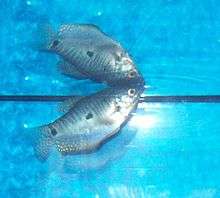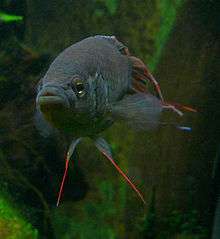Gourami
| Gouramis | |
|---|---|
 | |
| Dwarf gourami (Trichogaster lalius) | |
| Scientific classification | |
| Kingdom: | Animalia |
| Phylum: | Chordata |
| Class: | Actinopterygii |
| Order: | Perciformes |
| Suborder: | Anabantoidei |
| Family: | Osphronemidae van der Hoeven, 1832 |
| Subfamilies & Genera[1] | |
| |
Gouramis or gouramies /ɡuːˈrɑːmi/ are a group of freshwater perciform fishes that comprise the family, Osphronemidae. The fish are native to Asia, from Pakistan and India to the Malay Archipelago and north-easterly towards Korea. The name "gourami", of Javanese origin, is also used for fish of the families Helostomatidae and Anabantidae.
Many gouramis have an elongated, feeler-like ray at the front of each of their pelvic fins. Many species show parental care: some are mouthbrooders, and others, like the Siamese fighting fish (Betta splendens), build bubble nests. Currently, about 133 species are recognised, placed in four subfamilies and about 15 genera.
The name Polyacanthidae has also been used for this family. Some fish now classified as gouramis were previously placed in family Anabantidae. The subfamily Belontiinae was recently demoted from the family Belontiidae. As labyrinth fishes, gouramis have a lung-like labyrinth organ that allows them to gulp air and use atmospheric oxygen. This organ is a vital innovation for fishes that often inhabit warm, shallow, oxygen-poor water.
As food
Giant gouramis, Osphronemus goramy, are eaten in some parts of the world. In Indonesia, they are often deep-fried and served in sweet-sour sauce, chili sauce, and other spices. Canned, fried gourami are available in China, and throughout the world in oriental supermarkets. Gouramis are particularly found in Sundanese cuisine.[2]
In the aquarium

Gouramis, particularly the three spot and dwarf, are often kept in home aquaria. As labyrinth fish, they will often swim near the top of the tank. As with other tropical freshwater fish, an aquarium heater is often used. Gouramis will eat either prepared or live foods. Some species can grow quite large, and are unsuitable for the general hobbyist.
Compatibility
Generally regarded as peaceful, gouramis are still capable of harassing or killing smaller or long-finned fish. Depending on the species, adult and juvenile males have been known to spar with one another. Aggression can also occur as a result of overcrowding.
Gouramis have been housed with many species, such as danios, mollies, silver dollars, and plecostomus catfish.
Gallery
 Female and male dwarf gouramis (Colisa lalia) showing sexual dimorphism
Female and male dwarf gouramis (Colisa lalia) showing sexual dimorphism
 Paradise fish (Macropodus opercularis)
Paradise fish (Macropodus opercularis) Giant gourami (Osphronemus goramy)
Giant gourami (Osphronemus goramy) Three spot gourami (Trichopodus trichopterus)
Three spot gourami (Trichopodus trichopterus)
See also
The name "gourami" is used of several other related fish that are now placed in different families:
- Kissing gourami (the sole species in the family Helostomatidae)
- Climbing gouramis (family Anabantidae)
| Wikimedia Commons has media related to Osphronemidae. |
References
- ↑ Froese, Rainer, and Daniel Pauly, eds. (2014). "Osphronemidae" in FishBase. February 2014 version.
- ↑ http://kuliner.ilmci.com/resep/tag/ikan-gurame
- Goldstein, Howard (September 2005). "Searching for the Pygmy Gourami". Tropical Fish Hobbyist. 54 (1): 93. ISSN 0041-3259.
- Tan, HH and P Ng (2006). "Six new species of fighting fish (Telestei: Osphronemidae: Betta) from Borneo". Ichthyological Exploration of Freshwaters. 17 (2): 97–114.